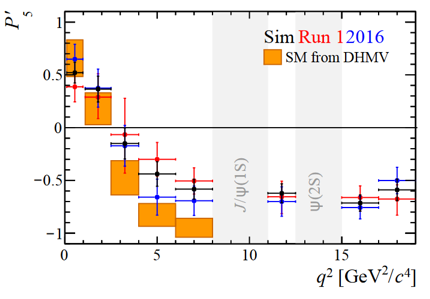Today at the CERN seminar, the LHCb collaboration presented an analysis of the angular distributions of B0→K*μ+μ– decays. The measurement uses the same technique as a previous measurement performed on the 2011 and 2012 data sample, but twice as many B0 decays were analysed, due to the addition of data taken during 2016. Compared with the previous LHCb results, the overall tension with the Standard Model (SM) is observed to mildly increase.
The analysis of B0→K*μ+μ– decays is considered to be a very promising way to search for effects of as-yet-undiscovered particles (see the CERN Courier article for an introduction). At the quark level this decay involves the transition from a b-quark to an s-quark, accompanied by the production of a muon pair (μ+μ–). The plots show the recontructed B0 mass for the Run 1 data (left) and 2016 data (right). The decays are sensitive to virtual contributions from new particles, which could have masses that are inaccessible to direct searches at the LHC. The reported tension with the SM predictions can be explained consistently in some new physics models. However, the analysis of these decays is complicated; the best sensitivity to new particles comes from the study of the angular distribution of the kaon and pion from the K* decay and the muons. Physicists from the LHCb experiment have studied different angular observables as functions of the invariant mass squared, q2, of the muon pair. A set of observables are analysed whose theoretical predictions are much less dependent on a good understanding of the hadronic physics involved in turning a B meson into a K* meson (so-called form factors). These observables are therefore ideal for searching for new particles in these decays. It is one of these observables, “P5‘“, that showed a local deviation with respect to the SM predictions at a level of 3.7 standard deviations (σ) in one q2 bin in the 2011, 1fb-1 data sample presented at the 2013 EPSHEP Stockholm conference and published soon after. The global fit of different angular distributions of the B0→K*μμ decays was performed in 2015 using the total Run 1 data sample of 3fb-1 and confirmed the puzzle, reporting differences with predictions based on the SM at the level of 3.4σ. These differences could be explained by contributions from physics beyond the SM, or by unexpectedly large hadronic effects that are not accounted for in the predictions. By taking into account some of these hadronic effects, and other effects, using theory input not available at the time of the 2015 publication, the tension with respect to the SM is reduced to 3.0σ.
The image shows the distribution of the P5’ observable as a functions of the mass squared of the muon pair, q2. The q2 regions affected by the presence of the J/ψ and ψ(2S) charmonium resonances, where theoretical predictions are prohibitively difficult to obtain, are not included in the analysis. The red points show the LHCb Run 1 results, the blue points represent the results of the analysis using the additional 2016 data set only, while the black points display the results of the simultaneous analysis of the both sets of data. The SM predictions are presented as orange boxes. These were taken from calculations described in theoretical papers [1] and [2].
The local tension of the P5’ observable in the 4.0<q2<6.0 and 6.0<q2<8.0GeV2/c4 bins reduces from the 2.8 and 3.0σ, observed in the Run 1 analysis, to 2.5 and 2.9σ in the simultaneous analysis. However, the global fit to several angular observables shows that the overall tension with the SM increases from 3.0 to 3.3σ. The global fit uses not only the P5’ distribution but also a few other distributions mentioned in the 9 August 2013 news. The results of the fit find a better overall agreement with predictions of a certain new physics model. (For experts: the data could be explained by modifying the real part of the vector coupling strength of the decays, conventionally denoted Re(C9).) Data-SM comparisons for the full set of observables are given in the paper.
LHCb physicists are systematically studying a principle of the SM of particle physics known as “lepton universality“, which states that the laws of physics treat the three charged leptons (electrons, muons and taus) identically, except for differences due to their different masses. Different ratios are investigated that compare beauty particle decays to different leptons (see RK, RK*0, R(D*), R(J/ψ) and recently RpK). These measurements revealed hints of deviations from lepton universality, none of which is significant enough to constitute evidence of new physics independently. However, according to theorists who study possible extensions of the SM, taken together these deviations suggest an interesting and coherent pattern. Is there anything common between lepton universality anomalies and angular distribution anomalies reported today? Well, maybe! According to theorists both types of anomalies can be coherently described by the same new physics models.
Read more in the LHCb CERN presentation, in the LHCb paper, in the CERN Courier article and also in the CERN update in English and French.


